There are six different types of salmon in the world and as all of them are extremely popular game and food fish, naturally, people ask a lot of questions about it. Salmon teeth are definitely one of the biggest topics of interest when it comes to this amazing fish.
Salmon are big predatory fish with plenty of sharp teeth. While dwelling in saltwater, their teeth are deeply embedded in their fleshly lips, but as they enter freshwater territory, their bodies slowly deteriorate, and the full size of their teeth becomes exposed.
Keep reading this article if you want to know how many teeth salmon have, how sharp they are, if they can bite through your fishing line (or you), and how to best unhook a salmon.
PRO TIP: Need to gear up for your upcoming salmon fishing adventure? Then check out this quality equipment on Amazon. It’s very cost-effective, durable, and will land you plenty of trophy salmon!
Do Salmon Have Teeth?
Both Atlantic salmon (genus: Salmo) and Pacific salmon (genus: Oncorhynchus) have teeth. All salmon species are carnivores that mostly prey on smaller species of fish, and like all predators, they need teeth in order to grab hold of their prey.
And hunt they do! No matter if they are in the sea, in rivers, or landlocked in big lakes, salmon are very active hunters that consume a lot of fish.
What’s really interesting and fascinating about salmon is the fact that their teeth are appearing to be fairly small and needle-like while the fish are dwelling in saltwater, which they do throughout most of their lives.
But when they are entering the freshwater of the river systems in which they were once born and are about to spawn, all Pacific salmon suddenly appear to “grow” enormous teeth when people spot them underwater or when fishermen catch them in the rivers.
Did You Know: While many Atlantic salmon also die after spawning, some actually survive, swim back into the sea and return the next year to spwn again.
Of course, their teeth aren’t growing at all but are simply being more exposed due to the salmon’s ongoing bodily deterioration.
Salmon are semelparous animals, meaning that they only reproduce once in a lifetime and then die.
The longer they stay in freshwater, the more their bodies deteriorate, as there is not much food for them available in the rivers and as they basically use up all of their energy reserves while swimming up the often strong currents of the rivers.
This is called the salmon run, a truly marvelous example of evolution and, in fact, quite rare in the fish world, as most fish species reproduce once a year and do not die of spawning.
And so, the more energy reserves they burn through, the thinner they get, and their once fleshly, full lips covered with rows of smaller teeth are no more.
Naturally, then, the salmon’s teeth are becoming extremely visible, as there is simply no flesh that surrounds them anymore.
That’s why Pacific salmon that are caught in freshwater can have really enormous and scary-looking teeth. So much so that they are often referred to as zombie fish.
Up next are a few visual examples of the different salmon species and their teeth.
King Salmon Teeth
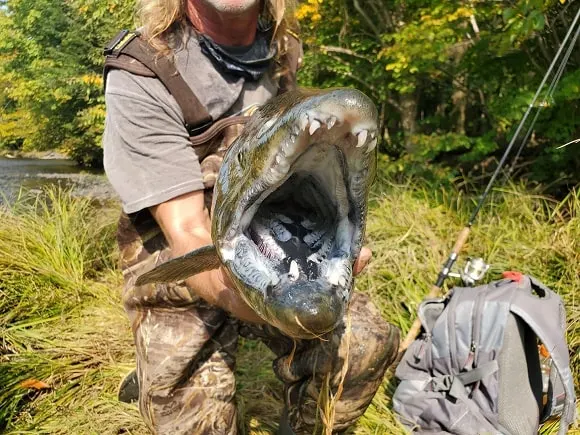
King salmon not only have really large teeth, but as the picture shows, they also have several rows of them.
All those scary teeth make the fish look like a prehistoric monster of some sort! If you happen to catch a fish like that, you’ll know why they are called king salmon; they are truly majestic creatures!
Chinook Salmon Teeth
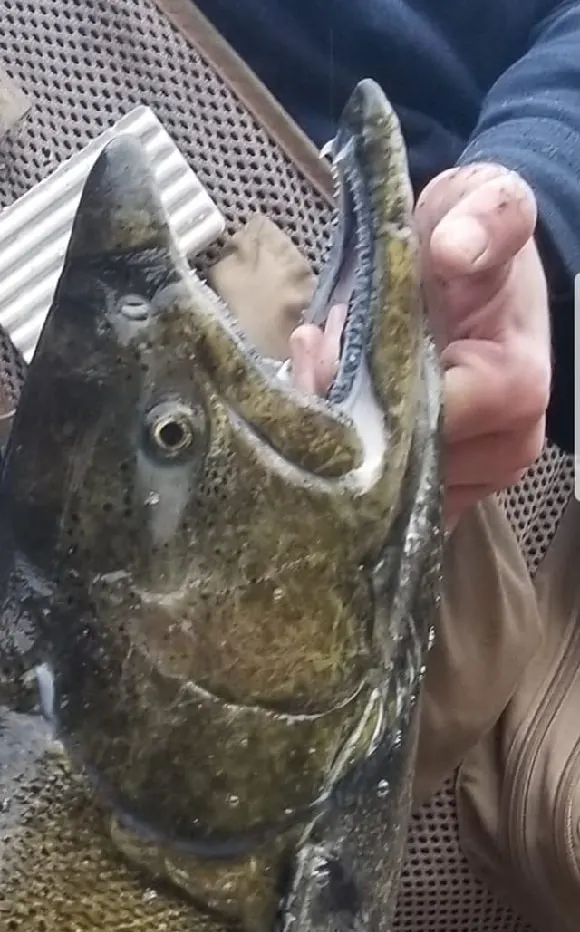
Chinook salmon is really just another name for king salmon and one that is used mainly in Alaska and Canada, while the rest of the United States calls them king salmon.
The above image shows a caught chinook that hasn’t been in freshwater for very long, as most of its teeth are still relatively “small”.
It is in this still early stage of their deterioration that the salmon most resemble their former saltwater selves.
Sockeye Salmon Teeth
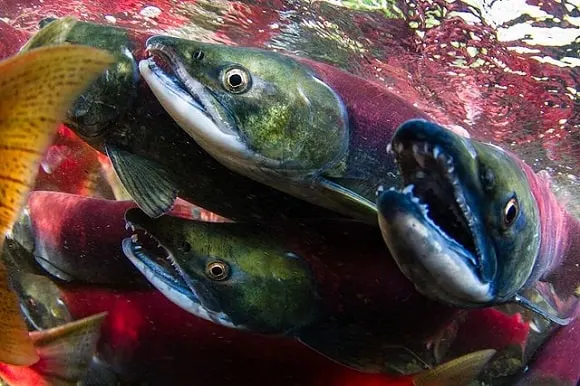
(By Oregon State University – sockeye salmon, CC BY-SA 2.0)
Notice the disproportionally large teeth on those sockeye salmon!
The image really shows how much flesh the fish are losing around the lip and mouth area during their spawning journey up the rivers.
It makes them look more like piranhas than salmon, doesn’t it?
Chum Salmon Teeth
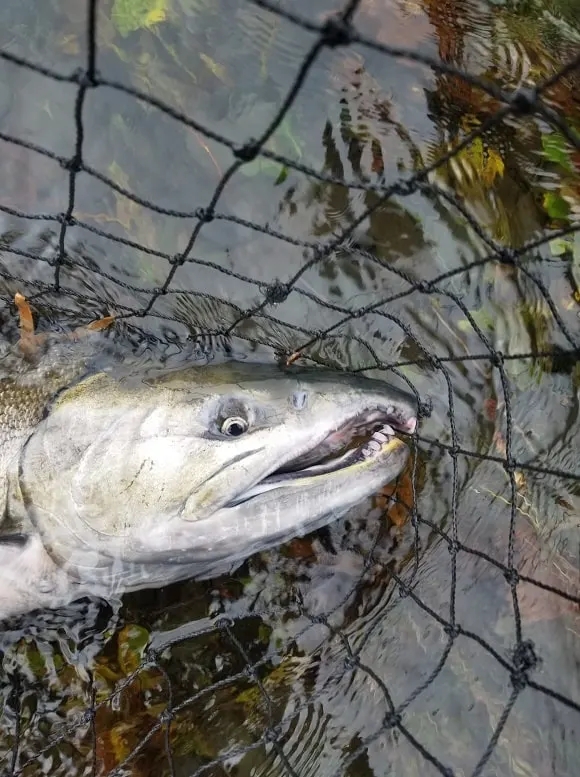
Do you see the chompers on that chum salmon? Its front teeth almost look like the teeth of a human, don’t they?
Once again, the start of the salmon’s deterioration circle is brilliantly illustrated in this image, and on this specimen, you can really see how big salmon teeth can get!
Coho Salmon Teeth
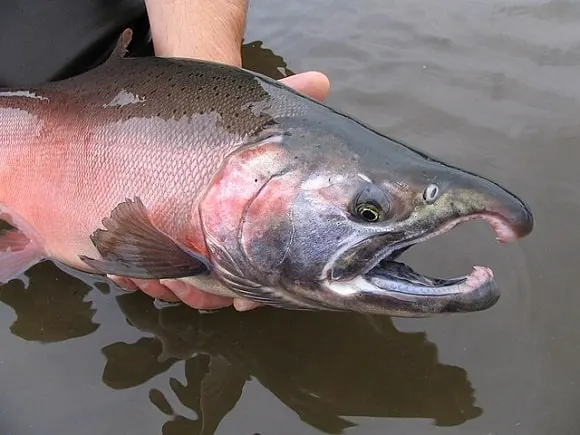
The coho salmon’s teeth are commonly somewhat smaller and less pronounced than those of the other Pacific salmon species.
When they start their deterioration process, it is mostly only their incisors that will be well visible and “larger”.
The image above shows the coho’s typical cluster of front teeth very well.
Pink Salmon Teeth
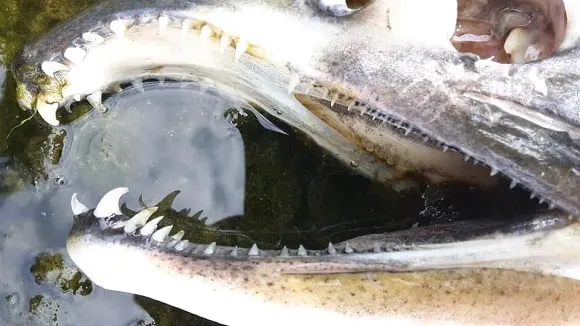
The teeth of the pink salmon are set somewhat further apart from each other than most other salmon types’ teeth. Very often, they are also fairly narrow, pointy, and angled inward.
Together with the male pink salmon’s hooked jaw, the kype, its teeth make it look like an ancient fish species from the age of the dinosaurs, don’t you think?
Atlantic Salmon Teeth
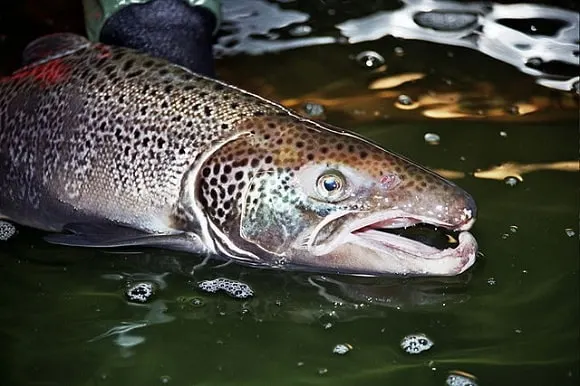
And last but not least, the Atlantic salmon. This species of salmon is different from its Pacific relatives in more ways than one.
Not only are Atlantic salmon teeth usually smaller than Pacific salmon teeth, but they aren’t always being exposed as much as their Pacific counterparts either.
That has to do with the interesting fact that Atlantic salmon do not always die after spawning. In fact, a good 10% actually survive the ordeal and return to their spawning grounds the following year.
Naturally, those fish won’t exhaust themselves to death, and hence, their bodies won’t deteriorate nearly as much, preventing their teeth from being exposed and “enlarged”.
Additionally, Atlantic salmon seem to be better adapted to the strong currents of the rivers they swim up, due mostly to their slim and torpedo-shaped bodies.
This leads to less exhaustion and, hence, to fewer dying fish.
RELATED ARTICLE: Want to know why salmon die after they have spawned? Then make sure to also read this article!
How Big Are Salmon Teeth?
We will have to distinguish between saltwater and freshwater salmon here, as the size of their teeth (at least the visible part of them) is different, depending on what environment the fish are found in.
In the ocean, salmon teeth are commonly only between 3 and 7mm (1/8-1/4 of an inch).
On the contrary, when they are in freshwater environments and have started their salmon run, the true size of their teeth is revealed. Here, salmon teeth can measure anything between 7 and 20mm (1/4-3/4 of an inch). Some specimens can even have teeth of up to 25mm (1 inch) in their mouths, but such sizes are extremely rare.
When they are in their natural saltwater environments and in normal physical condition, the salmon’s teeth are actually quite small, almost disproportionally so.
This holds especially true if you consider the size that salmon can reach! A fully grown king salmon, for example, can weigh more than 100lb and measure well over 50 inches. That’s a very big fish with very small teeth if you ask me!
But if you consider the salmon’s food sources in the ocean, small teeth actually make a lot of sense. Here, their main food sources are smaller fish (such as herring) and crustaceans (such as krill).
And so, for such small-sized prey, bigger teeth would be completely unnecessary!
RELATED ARTICLE: Read this article if you want to know at what time of year salmon are spawning
Are Salmon Teeth Sharp?
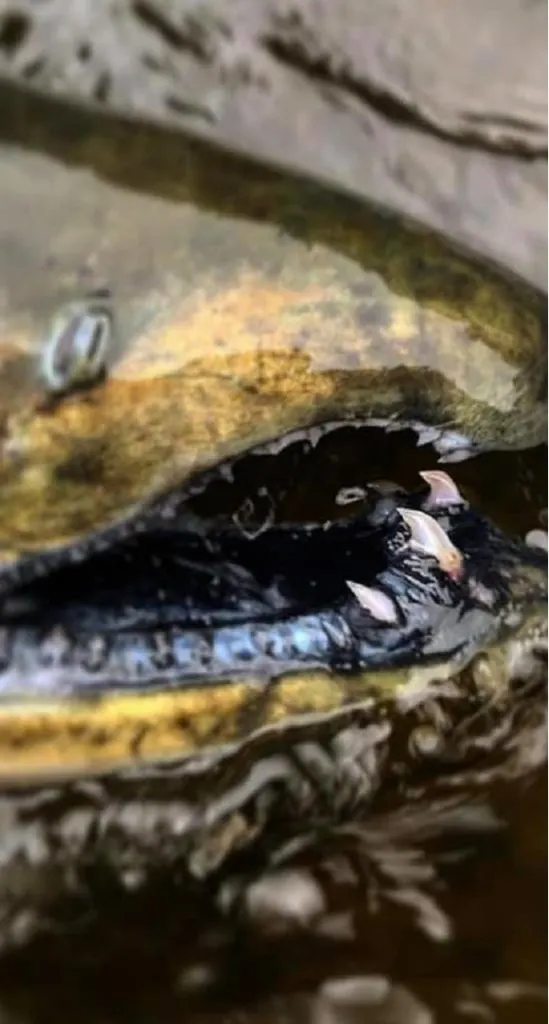
As the salmon have to be able to hold on to their prey, their teeth must manage to penetrate the fish they’ve caught.
They must be able to penetrate through both scales, shells, fins, skin, and bone, and for that to happen, the teeth need to be both very pointy and very sharp.
The salmon’s small prey also explains why most salmon types have rows of smaller, tightly set teeth.
If they’d be further apart, and/or bigger, like musky teeth, for example, the small prey they are hunting for could easily escape their grip.
Can Salmon Bite Humans?
Outright attacks by salmon on e.g. swimmers have literally never been reported, as salmon aren’t the most aggressive or territorial of fish species. On the other hand, plenty of anglers have been bitten or cut by salmon teeth while trying to unhook a fish or examine its mouth and teeth.
I have also read stories of fly fishermen on rivers who would have salmon swim up to their waders and start to nibble at their boots. But again, these are rare occasions, and the salmon probably acted out of pure curiosity!
Getting injured while handling salmon, especially the big and flopping around variety, is nothing uncommon though. And considering the size and sharpness of their teeth, particularly when it comes to salmon in freshwater (bigger teeth, remember?), you can definitely get hurt pretty bad if you are unlucky or simply not careful.
Pro Tip: I cannot tell you how many of my fishing trips were saved by an outdoor first aid kit. I fish for all kinds of toothy predators, and cuts and bites are more the rule than the exception. Being able to take care of your bleeding wounds on the bank or boat will most likely lead to a continued fishing adventure! So it’s definitely a smart investment. You can find a waterproof and very affordable first aid kit on Amazon here.
How Do You Unhook a Salmon?
The best and safest way of removing your caught salmon from the hook, given that you want to release it again, is to keep it in your landing net and, if possible, in the water.
Here, the fish will get plenty of oxygen via the river’s current and most likely also be calmer than on land, giving you an easier time removing that hook.
If you are forced to take it out of the water, try to use an unhooking mat or lay your landing net on the ground (preferably covered by wet grass or leaves) and carefully put the salmon on it.
Remember, a safely placed fish will be calmer and much easier to unhook on land!
Pro Tip: Most accidents with salmon teeth occur while trying to unhook the fish. Instead of using your hand to pull out that hook, use long-nose pliers! They will give you a firm and controlled grip on your hook and keep your hands away from those sharp teeth! Check out the nong-nose pliers I use for my predator fishing on Amazon here.
Can Salmon Bite Through Fishing Line?
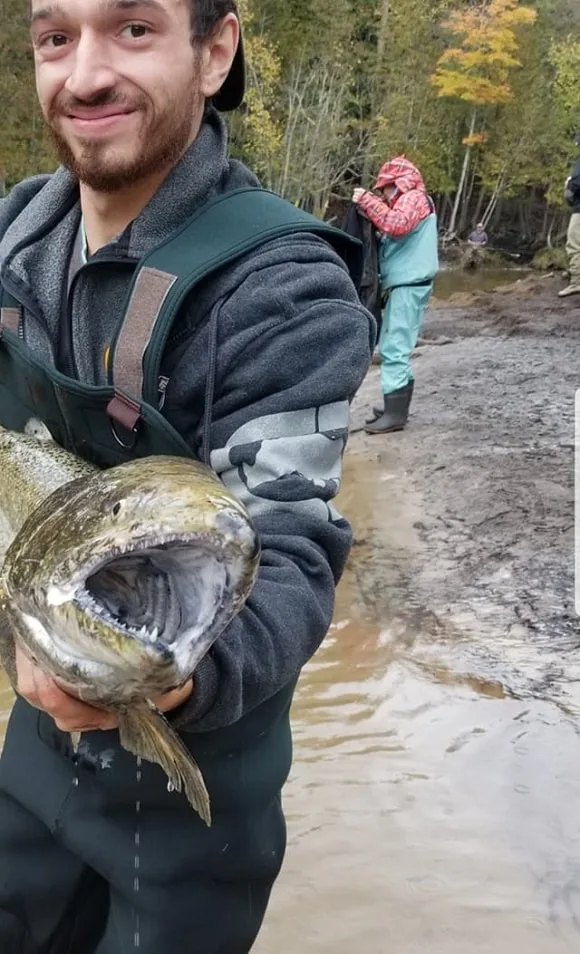
As salmon teeth are generally fairly pointy, they do not manage to cut through either monofilament, braid, or fluorocarbon fishing line.
With that said, it’s by no means guaranteed that you won’t experience the occasional bite-off, either due to line abrasion, a particularly sharp-toothed salmon, or simply due to the shear strength of the salmon that has broken more than one line throughout the ages!
In order to prevent line breaks, or the occasional unlucky bite-off, using an appropriate pound test for your mainline can save you a lot of fish!
Try to stick to the following mainline strengths for salmon:
| Fish Size | Pound Test | Type of Line |
| Small | 6-10 | Monofilament |
| Medium | 12-20 | Mono/Braid |
| Large | 25-40 | Mono/Braid |
Pro Tip: If you are fly fishing for salmon, you should use fly line instead. You can check out the optimal fly line for fishing with streamers and fishing with nymphs on Amazon here.
Do You Need a Leader for Salmon?
While wire leaders are essentially completely unnecessary, using both nylon or fluorocarbon leaders can be a very smart move when fishing for salmon.
Personally, I’d always go for a fluorocarbon leader of about a 15-20lb test, as you’ll want your end tackle to be as invisible and stealthy as possible, especially when fishing in clear river water.
Fluorocarbon is also way more abrasion-resistant than nylon!
Check out a really awesome and completely invisible fluorocarbon leader on Amazon here.
Can Salmon Teeth Damage Fishing Lures?
While salmon often won’t do much damage to your line or leader, their big teeth can certainly damage or crush your fishing lures!
Especially soft plastic baits, inline spinners, and crankbaits often fall victim to the salmon’s teeth and it happens fairly often that a lure is rendered useless after a violent and wild salmon fight.
This is something to keep in mind when lure fishing for salmon. Be prepared and bring a few extra lures with you when you head out. You don’t want to end up with an empty lure case when the salmon are at it!
Related Articles
- Do Trout Have Teeth?
- Norther Pike Teeth (Everything You Need to Know About Them)
- Do Carp Have Teeth? (Interesting Fish Facts)
Featured image courtesy of Tyler Friss

